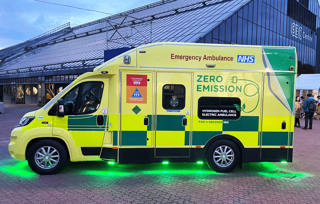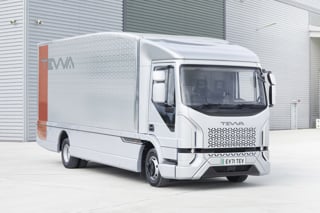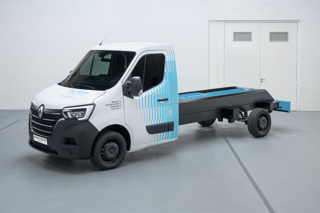By Dr Vidal Bharath, chief operating officer at Bramble Energy
In 2018, road transport accounted for 91% of UK domestic transport emissions.
Heavy goods vehicles (HGVs) accounted for 17% of this, with HGV traffic increasing by 10% between 2012 and 2018.
The movement of goods and people across the country has never been higher and the trend doesn’t look likely to change, but potentially could increase significantly.
What must change, and quickly, is how much carbon is being released into our atmosphere as a result of the constant movement of goods and people on our roads.
The UK Government released its Transport Decarbonisation Plan with an announcement of a £20 million investment this year to support industry in their plans to develop cost-effective, zero emission HGVs and refuelling infrastructure across the UK.
This is a drop in the ocean, which would only be made worse if we chase the wrong solutions to answer the decarbonisation challenge.
Hydrogen has long been placed as the ‘future’ solution, due to high costs and deployment on a large scale but with its versatility as an energy vector and the fact that it’s only emission is water it is well worth the investment to keep our haulage industry running - in a clean and efficient manner.
Why hydrogen and not batteries?
A typical 7-tonne heavy duty truck, has a maximum weight allowance of 36 tonnes (fuel, powertrain, payload) and can do on average a round trip of 1,000 miles between depot and delivery site.
With a 9-tonne powertrain and fuel tank, the remaining payload capacity is just 20 tonnes and the vehicle can refuel in 20 minutes. How can we decarbonise?
Obviously, the first place to start is batteries.
They are a widely available zero emission solution and most of us will know someone who has a battery electric vehicle (BEV) they use for daily transport.
When it comes to heavy duty vehicles, there are several reasons why batteries are not the best route to follow - The main issue is the recharging infrastructure.
When thinking about this 1,000 mile journey between depot and delivery, it is essential to have rapid chargers for BEVs.
HGVs are naturally exceptionally power hungry and this has a knock on effect with the electricity grid.
Rapid charging will also have an effect on battery degradation and so the lifetime of the battery itself.
Not to mention that having to factor in downtime for recharging takes a toll on the labour force with more drivers out of service for longer periods of time and with the current shortage of drivers the UK is experiencing this has massive implications on keeping the logistics industry on the move.
These types of chargers are unlikely to be ubiquitous, in fact there currently aren’t any suitable for HGVs.
The UK has somewhat touted electric as the ‘silver bullet’ in their transport decarbonisation plan and for the complex logistics network, it would require massive infrastructure installations on the way to many delivery locations, and of course, at both start and finish destinations - which at this point is even less likely in the timeframe of the net zero 2050 target.
So, what are the other zero emission, electrification options that do not require wholesale revamping of our National Grid infrastructure?
There’s one - hydrogen fuel cells. Hydrogen fuel cells can replace or complement (range extender) an existing battery drivetrain and can provide fast refuel, zero emission power.
Where are all the hydrogen trucks?
There are a number of automotive companies putting efforts into the development of hydrogen fuel cell solutions for the haulage industry, including commercial vehicle manufacturer, Daimler.
Hyundai has already seen it’s fleet of Hydrogen XCIENT trucks surpass 1 million kilometres in Switzerland this year.
However, we come back to the refuelling infrastructure.
The good news is, deployment of it on scale for hydrogen fuel cell vehicles has a much simpler solution.
You can fill your hydrogen vehicle in the same way and timeframe as its diesel counterpart, the best news for end users ruled by time constraints.
In the UK, we could service this demand by using our current refuelling stations and the implementation of hydrogen refuellers could be time efficient and self-contained.
What this means is a complete end-to-end refuelling solution using renewables to generate hydrogen; with no additional strain on the grid.
We could comfortably deploy hydrogen for refuelling any vehicle.
Whilst the UK only currently has a handful of hydrogen refuelling stations around the world, the likes of Germany, California, Japan and China have numbers in the hundreds and are growing fast.
These stations provide a centralised, ubiquitous green refuelling source that can be deployed without massive infrastructure and grid overhauls.
Why stop at trucks!
Achieving net zero targets requires solutions that drastically reduce emissions, whilst providing a comparative or better end user experience.
Hydrogen does exactly this and has the ability to completely revolutionise the way in which we transport goods and people across the globe.
And even better than that? Because of its centralised refuelling nature, hydrogen fuel cells can also be deployed at rail, marine and aero depots so we can continue business as usual.
Why stop at trucking? The climate crisis doesn’t.





















Login to comment
Comments
No comments have been made yet.